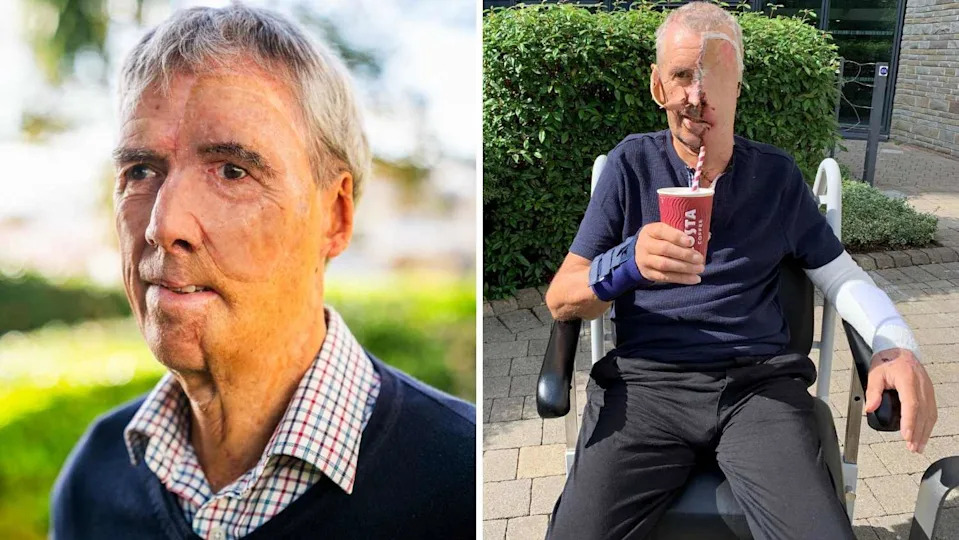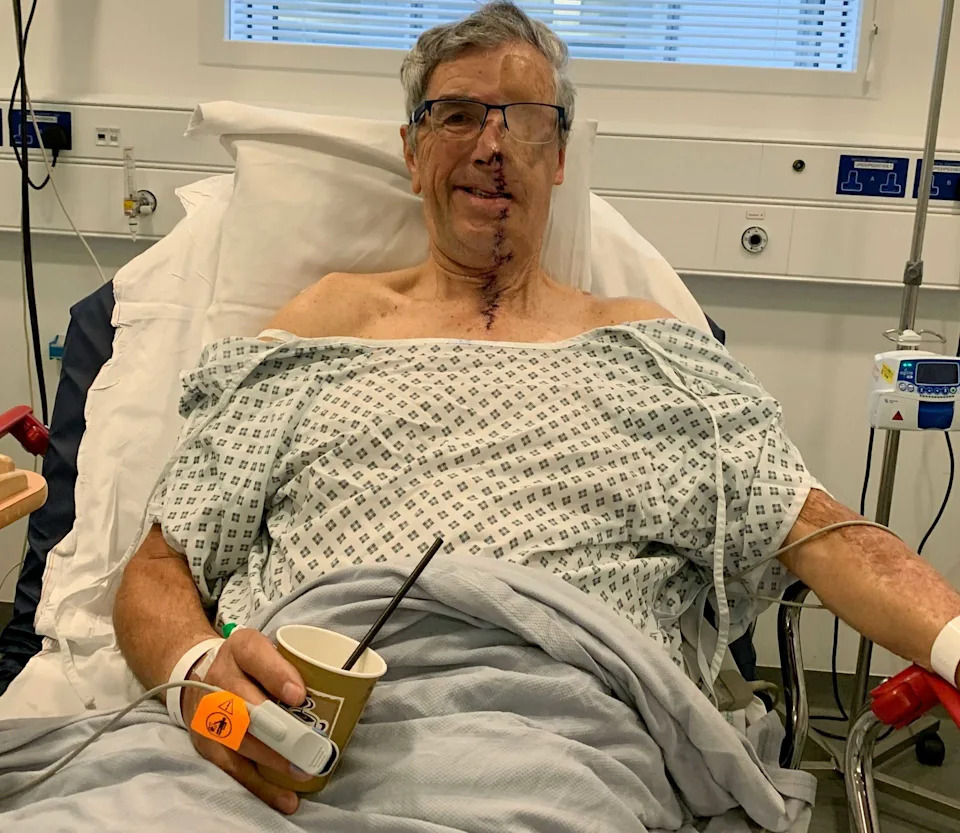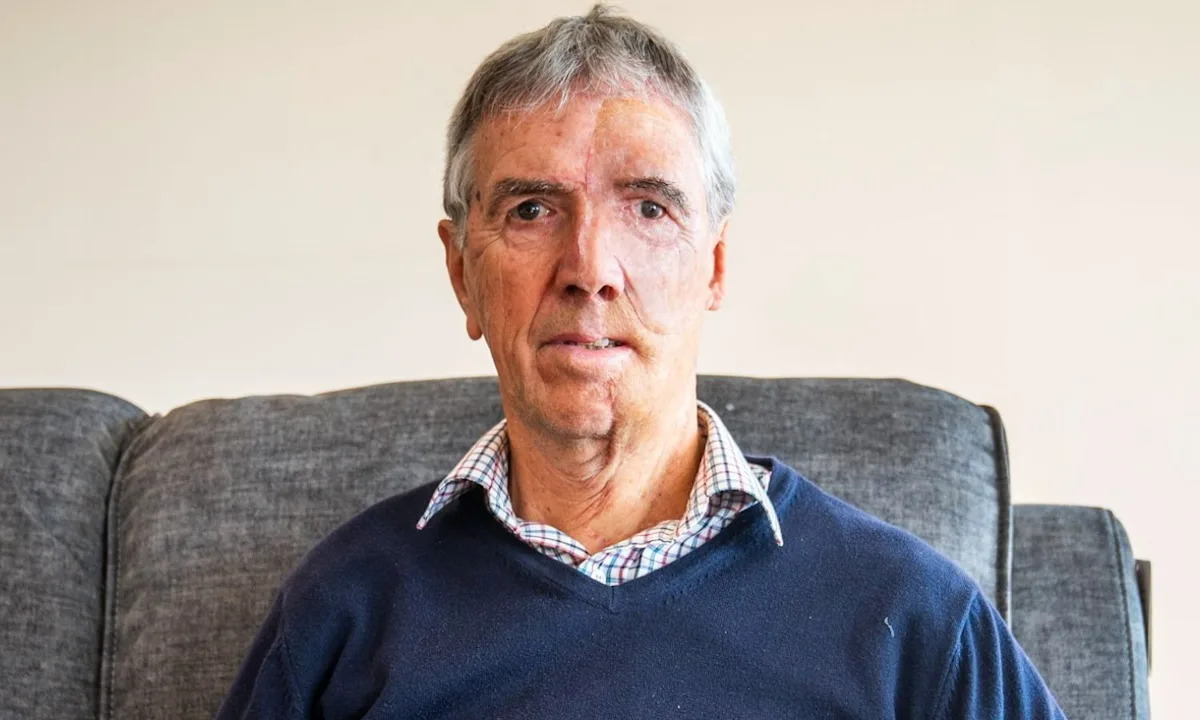A cyclist whose face was severely disfigured by a drunk driver is the first person to benefit from a new NHS body parts printing centre – which has built him a new 3D printed face.
Dave Richards, 75, was “lucky to survive” the crash in 2021, which left him with a damaged back and pelvis and multiple broken ribs on one side of his body.
The grandfather-of-four from Devon also received full thickness burns to the side of his face including his eye, nose and part of his neck.
During his recovery, he was referred to Reconstructive Prosthetics, which has just opened The Bristol 3D Medical Centre, which uses state of the art digital technology and specialist reconstructive equipment.
It is the first of its kind in the UK to have 3D scanning, design and printing of this kind in a single NHS location.

Richards has said he is starting to feel more confident about his appearance as his recovery journey continues. (SWNS)
As part of his treatment, Richards received a 3D prothesis that fits the space on his face and mimics his hair colour, eye colour and skin.
After his accident, surgeons tried to save his eye but opted to remove it due to fears that any infection could spread down the optic nerve to his brain.
“The decision was then made to go for free flap, taking tissue with blood arteries and veins and plumbing it into my neck, the flap completely covering the side of my face.
“The surgery was a complete success, though I have had to have two follow-up surgeries to release tightened scar tissue.”
Watch Dave Richards speak about groundbreaking surgery
When he was told of the Bristol site’s 3D capability, Richards said it “opened up a whole range of possibilities”, although he says attaching a new face onto his head was “not the most pleasant of processes”.
“They relied on various moulds and wax impressions from manual processes, they took lots of photos for a record of how it looked, and there was lots involved in making the moulds and casts on your face by covering your nose and mouth.
“In the early days of my recovery, I felt very vulnerable, and would not expose myself to social situations.
“It took me a long time to feel comfortable about my image, how I thought people looked at me and what they thought of me – but I have come a long way in that respect.

Dave Richards – Man with first ‘NHS 3D printed face’ – SWNS
“I was keen to explore anything that could be done to alter the visual aspects of my injuries to give me more confidence.”
Richards started indoors cycling five months after his accident, and has been building up the confidence to cycle outside again.
He continues to visit the Bristol 3D Medical Centre and has also received a large orbital prosthesis and neck scar splints, also produced using 3D technology, to help soften scar tissue.
“I was amazed,” he said. “It definitely has helped because it has put pressure on the scar line, softening the tissue and making life easier to wear my face prosthesis.”
Despite initially feeling “sceptical” towards his treatment, Richards says he is “glad” he has followed through, adding: “It has got me to where I am today.”
“I always weigh up whether the benefits outweigh the risk, I had that on day one,” he added.
How do these 3D printed prosthetics work?
During Dave’s recovery at the BRI burns ward, he met two specialists who spoke to him about the potential for going down the route of prosthetics.
Senior reconstructive scientist at the North Bristol NHS Trust, Amy Davey, said a process called surface scanning allows patients’ bodies to be scanned while moving.

Dave Richards went back to cycling five months after his accident. (SWNS)
Not only does it allow that, the technology can use the body’s movement to aid the prostheses to accommodate movement of 3D printed body parts.
“The 3D printers used involve advanced plastic resins whose properties allow direct application to the skin.
“Another printer at the centre has the ability to produce materials that closely resemble those of the bones themselves, allowing a far more ’natural’ implant.
“3D scanning over time can be useful in quantifying a patient’s progress and enabling any necessary adjustments to be carried out, particularly for treating and monitoring scars.”
‘I very nearly lost my life – and live with pain on a daily basis’
On 21 July 2021, Dave was out cycling with two of his friends in Mere, off the A303 in Wiltshire, when they were hit by a speeding drunk driver.
“It was a lovely sunny day, and not long into the ride, we were going up a hill on a B road, and this guy comes up behind us at speed, and over the drunk drive limit,” the lifelong fitness fanatic said.

Dave Richards said he was ‘sceptical’ at first but is glad he went ahead with the treatment. (SWNS)
“He was on his phone, racing up behind us and we were all in line. He wanted to swerve around us, but there was a car coming the other way, so it was either smash into the car or smash into us.
“My two friends got hit, and were thrown clear of the car, but I got trapped under the car, and was rolled along, with the engine and exhaust burning through one side of my body and the other side being crushed by the car.”
The man who caused the accident was sentenced to three years and banned from driving for seven years. He was released from prison after one and a half years for good behaviour, and as he pleaded guilty from the start.
Richards said: “As you can imagine I am not best pleased with his reduced sentence as I very nearly lost my life and have to live with all the pain from my injuries on a daily basis.”
Read more
Click below to see the latest South West headlines


